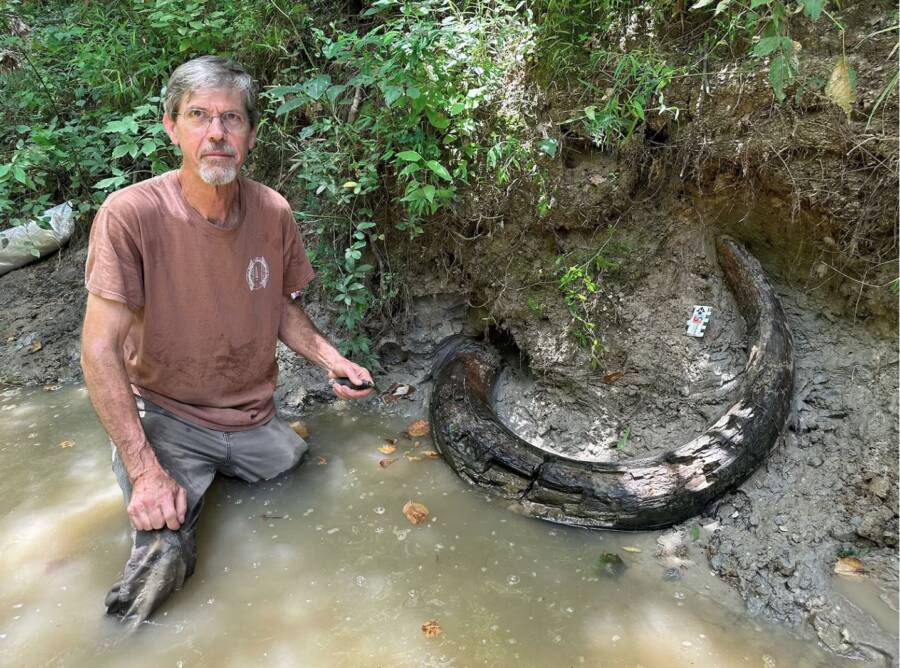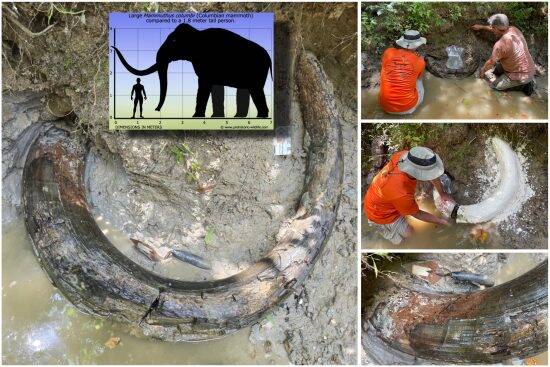The discovery marks the first time a Columbian mammoth tusk has ever been found in the state.

James E. Starnes/MDEQEddie Templeton with the seven-foot mammoth tusk he discovered.
In rural Madison County, Mississippi, amateur fossil hunter Eddie Templeton just made a mammoth discovery. As he was walking along a creek earlier this month, looking for fossils and other artifacts, he stumbled upon a massive tusk.
Though he initially believed it to be a mastodon tusk, Templeton later learned it was actually a fully intact tusk from a Columbian mammoth — the first ever found in the state.
How Eddie Templeton Found The Mammoth Tusk
Eddie Templeton often goes out on fossil hunts, walking along the rural creeks of Mississippi with eyes peeled. During one of these treks on August 3, 2024, he noticed something sticking out of the bank of a creek.
“Probably two-thirds of it was showing,” he told ABC News. “I thought, Wow this is a lot of tusk.”
As he worked to dig it out of the earth, he realized that this wasn’t just a portion of the tusk — it was the entire thing, measuring roughly seven feet in length.
“It was exciting. I knew it was a tusk,” Templeton told the Clarion Ledger. “It didn’t occur to me it could be a mammoth tusk instead of a mastodon tusk until later. When I learned it was a mammoth and not a mastodon, I got even more excited. I’ve never found any part of a mammoth. I always hoped to find a part of a mammoth, but that’s pretty rare down here.”

MDEQPhotographs taken while the tusk was in situ.
According to the Mississippi Department of Environmental Quality (MDEQ), “pretty rare” is an understatement.
“Most fossil tusk ivory found around the state are just fragments and most are likely to be attributable to the more common mastodon,” the department said in a statement.
Mastodons lived in the area thousands of years ago, and they were much more common than mammoths for a simple reason: They could survive in a wide variety of environments. Mammoths, on the other hand, were much more “specialized” creatures, typically inhabiting a more limited set of areas.
“This is not something you see every day,” said MDEQ geologist James Starnes. “This takes the cake when it comes to Ice Age fossils.”
There Was A “Sense Of Urgency” To Get The Fossil Out
Given the rare nature of this find, Templeton was eager to remove the fossil from the creek.
“There was kind of a sense of urgency to get it out,” he said, “because once it starts drying, this process of delamination starts, and it can go downhill pretty quick. From the beginning, our intention was to try to get it protected, out of the creek, and to a better environment to protect it.”
Of course, the job was too big for one man alone. Templeton contacted MDEQ, who sent out a team of paleontologists to assist Templeton in the excavation. The team took photographs of the tusk in situ, then wrapped it in a protective plaster jacket.

MDEQ/FacebookThe tusk weighed about 600 pounds when wrapped in its plaster casing.
The plaster-wrapped tusk was loaded onto a makeshift gurney and placed on a truck. It was then transported to the Mississippi Museum of Natural Science for preservation and study.
Upon further analysis, the true significance of this discovery became clear; Templeton was astonished to learn that he’d stumbled upon the first Columbian mammoth tusk ever found in the state of Mississippi.
These giant creatures roamed North America between 10,000 and 20,000 years ago and were even bigger than woolly mammoths, weighing upwards of 10 tons. In fact, Starnes said the Columbian mammoth was the largest mammal known to ever walk Mississippi.
“It was huge,” he said. “This was a big, big animal. This would have dwarfed a woolly mammoth.”
Paleontologist George Phillips told the Clarion Ledger that next steps for the tusk include drying and preserving it. While he said he wasn’t sure when it would be made available for public display, the Mississippi Museum of Natural Science hopes to have it on exhibit as early as March 2025.
After reading about this mammoth tusk found in Mississippi, read about 11 of Earth’s most unbelievable prehistoric animals. Then, learn about terror birds, the prehistoric animals of your nightmares.





